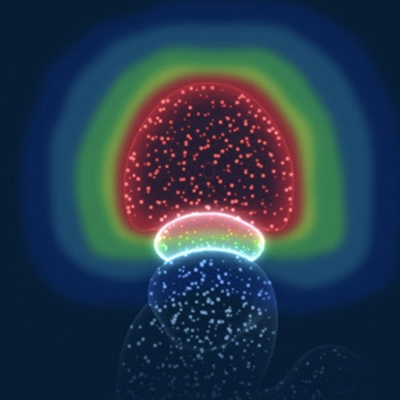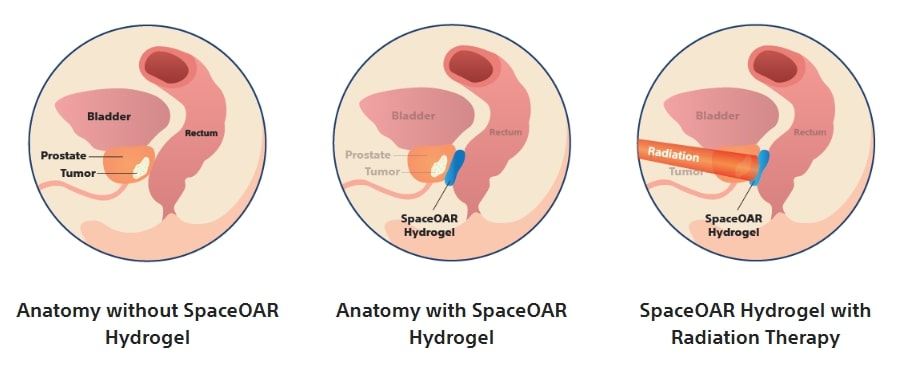Rectal Spacing

Rectal Spacing for Prostate Cancer Radiation Therapy
At Western Radiation Oncology in the San Francisco Bay Area, we provide advanced rectal spacing solutions that protect healthy tissue during prostate cancer radiation therapy. Since 2012, our prostate cancer specialists have used innovative hydrogel spacers to improve outcomes and reduce side effects for patients undergoing both external beam radiation therapy (EBRT) and low dose rate (LDR) brachytherapy.
What Is Rectal Spacing and Why Is It Important?
A rectal spacer is a revolutionary product that both reduces negative side effects associated with prostate radiation therapy and allows for better radiation delivery to the prostate. One issue that prostate cancer patients face during radiation therapy is that the healthy tissue and organs surrounding the prostate are also exposed to unwanted doses of radiation. When the rectum, which lies next to the prostate, is exposed to radiation, patients may suffer bowel issues that can significantly disrupt their quality of life. For decades, Radiation Oncologists have needed to balance dose delivery to the prostate while attempting to minimize unwanted radiation to the rectum.
Rectal spacing allows Radiation Oncologists to dramatically reduce the exposure of radiation to the rectum by inserting a gel that creates space between the prostate and rectum. This space diminishes the risk of both short and long term rectal complications, as well as allowing for better and safer delivery of radiation to the prostate.
Our Expertise in SpaceOAR and Barrigel
The physicians at Western Radiation Oncology have been offering SpaceOAR to patients with prostate cancer since the product’s inception in 2012, and were lead participants in the pivotal clinical trial which established its use.
We now also offer:
- SpaceOAR Vue: A next-generation version visible on CT scans, improving treatment accuracy and target localization
- Barrigel: A sculptable, biodegradable spacer made of hyaluronic acid that provides additional customization and anatomical fit
Your WRO physician will discuss the specifics of rectal spacing with you at the time of your initial consultation.
Book an appointment
If you’re seeking advanced, compassionate prostate cancer treatment in California, contact Western Radiation Oncology today. Our team will walk you through all options—including SpaceOAR and Barrigel—to ensure your care is personalized and safe.




FAQs
Rectal spacing is a quick, fifteen minute outpatient procedure, whereby a liquid gel is inserted using ultrasound guidance between the prostate and rectum, typically 1-2 weeks prior to the patient’s scheduled radiation therapy. Once implanted, the liquid solidifies in seconds creating ample space between the prostate and rectum.
The rectal spacer procedure can be performed under local, regional, or general anesthesia. However, the vast majority of our patients undergo the procedure with local anesthesia only and remain awake throughout. The procedure is typically quick and well-tolerated.
Most patients experience little to no side effects after rectal spacer placement. You can typically resume normal activities immediately after the procedure. A few patients report mild pressure during the gel insertion or slight discomfort at the injection site afterward, but these effects are rare and short-lived.
Yes. Both SpaceOAR and Barrigel are FDA-approved and well-tolerated:
SpaceOAR placement is a safe, FDA-approved procedure with minimal potential for complications. The Hydrogel itself is highly-absorbent and made mostly of water (90%) and polyethylene glycol (PEG), a common material found in existing surgical sealants. After approximately six months, the gel is absorbed by the body and passed through the urine. You will not feel the SpaceOar while it is present in your body.
Barrigel is a sculptable, biodegradable gel made from hyaluronic acid, a substance that is safe and naturally occurs in the body. It is gradually broken down by enzymes within the body and is eliminated via the lymphatic and urinary systems. It typically takes about 6-12 months for this degradation process to occur. You will not feel the Barrigel while it is present in your body.
As with any intervention, there is a risk of complications. Potential rare complications associated with rectal spacing include, but are not limited to: pain associated with the gel insertion; needle penetration of the bladder, prostate, rectal wall, rectum or urethra; injection of the gel into the bladder, prostate, rectal wall, rectum or urethra; local inflammatory reactions; infection; injection of air, fluid or the gel intravascularly; urinary retention; rectal mucosal damage, ulcers, necrosis; bleeding; and rectal urgency. Please talk to Dr. Kurtzman, Dr. Agarwal, or Dr. Shumway about the risks involved with the use of SpaceOAR or Barrigel.
The purpose of rectal spacing is to prevent the negative side effects suffered by the bowels when the rectum is exposed to radiation. A common side effect is an inflammation known as radiation proctitis. Symptoms of radiation proctitis may include rectal bleeding, mucus or bloody discharge from the rectum, a frequent sense of needing to empty the bowels, abdominal cramps, diarrhea, and more. In order to prevent this, your WRO doctor may recommend rectal spacing prior to your radiation therapy.
Absolutely. rectal spacing is typically inserted 1-2 weeks prior to the LDR brachytherapy treatment.
©2025 Boston Scientific Corporation or its affiliates, which include Western Radiation Oncology. All rights reserved.
©2025 Teleflex Incorporated or its affiliates, which include Western Radiation Oncology. All rights reserved.
